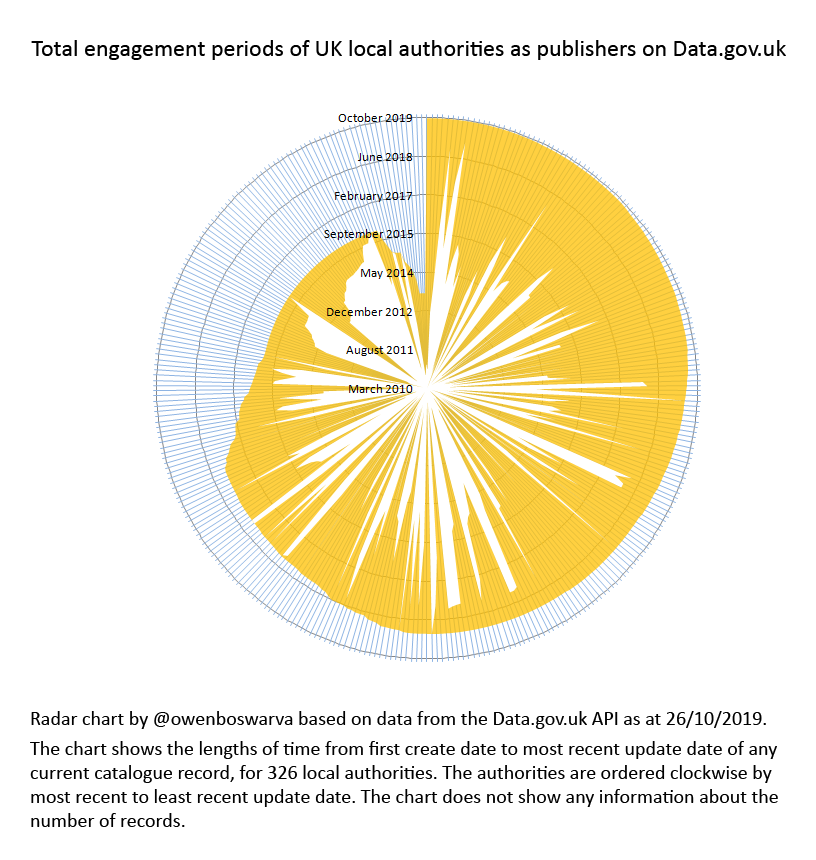I've compiled a list of all the open data portals and landing pages maintained by local authorities in the UK, and put the links in an Excel workbook and on an interactive map.
If you think I've missed any similar resources please let me know. I've carried out this exercise a few times before (most recently in October 2017), so the list should be reasonably comprehensive.
Following are stats on the resources I found, broken down by country and type of local authority:
| Authorities | Portals | Landing pages | Either | |
| England totals | 356 | 49 (14%) | 305 (86%) | 316 (89%) |
| Unitary Authorities | 58 | 13 (22%) | 51 (88%) | 54 (93%) |
| Non-metropolitan Districts | 192 | 13 (7%) | 171 (89%) | 174 (91%) |
| Metropolitan Districts | 36 | 9 (25%) | 32 (89%) | 33 (92%) |
| London Boroughs and GLA | 34 | 6 (18%) | 25 (74%) | 26 (77%) |
| Counties | 26 | 7 (27%) | 23 (89%) | 25 (96%) |
| Combined Authorities | 10 | 1 (10%) | 3 (30%) | 4 (40%) |
| Scotland | 32 | 10 (31%) | 13 (41%) | 16 (50%) |
| Wales | 22 | 0 (0%) | 5 (23%) | 5 (23%) |
| Northern Ireland | 11 | 0 (0%) | 2 (18%) | 2 (18%) |
| Crown Dependencies | 3 | 1 (33%) | 1 (33%) | 2 (67%) |
| UK totals | 424 | 60 (14%) | 326 (77%) | 341 (80%) |
For the purposes of this exercise I was mainly looking for either of two things:
- a general-purpose portal, with a character distinct from the local authority's main website, that provides download access to a collection of open datasets maintained by the authority, or
- a landing page on the local authority's main website that provides access to a collection of open datasets produced by more than one of the authority's departments, with some reference to either "open data" or the Local Government Transparency Code.
I didn't count portals dedicated only to the publication of geographic open data, or third-party portals that republish the authority's data. However I've highlighted some of those additional sites in notes.
The list and map are only intended to provide an entry point for exploring local open data. I haven't made any attempt to compare the volumes of open data published by individual authorities. Even among authorities with their own portals there are wide differences in the range and number of datasets published.
Overall there has been a small increase in the total numbers of portals and landing pages since 2017. The most noticeable increase is in Scotland. Dumfries and Galloway, Stirling, Aberdeen, Renfrewshire, and Dundee have all launched portals in the past two years, and 50% of Scottish councils now maintain either a portal or landing page.
However local authorities outside England are still significantly less likely to have an open data programme in place. In England compliance with the Transparency Code, which specifies requirements for publication of spending data and other datasets, is the main driver for maintenance of a landing page.
Councils in urban areas and with large populations are the most likely to maintain a portal for publication of a wider selection of data. The big metropolitan councils all have open data portals: London, Birmingham, Leeds, Glasgow, Sheffield, Manchester, and Bradford.
Liverpool is the largest urban council that does not have its own open data portal. However some larger non-metropolitan unitaries also do not have portals: Cornwall, Country Durham, and Wiltshire.
All of the 26 English counties except Somerset now have either an open data portal or landing page. Excluding the county councils, Fife is the largest UK local authority by population with neither a portal nor a landing page for open data.
Many local authorities rely on third-party sites to provide public access to their data, of course. This includes some that do not have a portal or landing page of their own – 48 of those authorites list datasets in the Data.gov.uk or OpenDataNI catalogues.
However local authorities that list their data on Data.gov.uk don't necessarily maintain that engagement over time, as this chart shows:

A few basic recommendations:
- All local authorities publish some datasets on their websites that are eligible for re-use as open data. Often individual datasets are published here and there in situ with other public information. That's fine. But every authority should, at minimum, maintain a landing page that signposts all of the datasets it makes available. (In England landing pages were a key proposal in MHCLG's 2016 consultation on updating the Transparency Code.)
- I won't argue that every local authority should have its own portal dedicated to open data. However authorities that do maintain a portal should do more to promote public awareness of it. Quite a few local authorities that have both a portal and a landing page for open data don't mention the portal on the landing page. Bradford, for example, has a landing page that is to all appearances comprehensive but does not link to either the Council's Data Hub or its separate Geospatial Open Data Portal.
- Local authorities should review their existing public data to make sure it is fully re-usable as open data, if eligible. Some councils have good intentions but are still publishing data in inaccessible formats such as PDF, or do not make it clear that the data is published under an open licence.